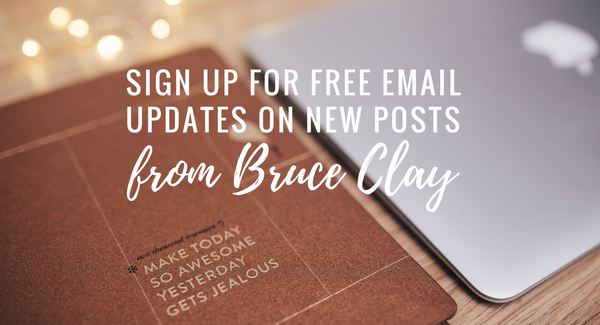35 White Hat Link Earning Ideas was originally published on BruceClay.com, home of expert search engine optimization tips.
High-quality backlinks are a website’s friend; they help establish a positive reputation about your brand and business to customers and search engines.
When you have organic inbound links pointing to your website from another website, search engines will bump up the E-A-T factor (Expertise, Authority, Trust) and ranking gains will follow.
Of course, this is barring a variety of possible negative consequences of paid or manipulative links that can hold a site back. (If you know the pain of Google penalties, you might find SEO penalty services of use.)
The problem is that not all backlinks are the result of real business relationships. But that’s also the key!
Search engines value backlinks only when they’re the authentic results of your marketing strategies and not because you opened your wallet and bought them. To cover this base, do not buy links. In any form. If you’re still interested in more traditional methods and the “dos and don’ts,” check out our link building tutorial for more information.
Think of links as the natural byproduct of happy customers and impressed industry affiliations that are attracted to the efforts or achievements of an individual or organization. We use the term “link magnet” to describe a campaign to attract links as a result of doing something outstanding or offering something exceptional. Like metal attracted to a magnet, people will naturally share and link back to your content or campaign by sheer power of its attraction factor.
Below is a list of 35 natural and safe (white hat) link earning ideas that have the potential to produce quality backlinks that support a healthy website and are an honest reflection of your reputable brand.
Reward Loyalty
Brand loyalty is a powerful emotion to capitalize on. Any kind of giveaway or discount for repeat or long-term customers is going to have a positive impact.
If you have a customer that repeatedly buys a product from you, then you have a loyal customer who might write about you. Maintaining loyalty is where the work is.
One way to build loyalty is to reward a loyal customer with a discount on something that they regularly purchase or is related to something they’ve purchased.
Send them a free T-shirt, which sounds basic and boring, but it’s free advertising for you and the customer feels appreciated. At the very least he/she will think the company is trying to be nice, even if it is a simple gift like a key chain or a sticker with a handwritten note.
Non-Profit Partnership
If you give a small percentage of your profits to a charity or host a fundraiser in the name of a charity, you automatically become a “good guy” in the public eye.
This is a pretty basic concept and it’s great for building brand awareness/opinion. It can also be the tipping point on the scale when a potential customer is choosing between two products.
If your competitor isn’t making the same charitable contributions and the customer is aware of your good will, they’re more likely to choose your product or service because of the positive intent of the company.
At the same time, people love to read “nice guy” stories and many forms of charitable work, are likely to draw in some visitors and links.
Other online publications will want to suck up a bit of the potential traffic too, which will lead them to create content that highlights the partnership or fundraiser in order to drive traffic on their own site.
Be authentic with this approach, however, as consumers can smell a scam a mile away. Choose a charity carefully and one that reflects your consumers wishes. Maybe even ask your consumers to tell you which charity to support each year.
Publish Research
Solving a problem or proposing a solution to an industry-wide problem is a little easier said than done, but it’s sure to have a large impact and can be approached in terms of conducting research. Conducting research doesn’t have to be an overly complicated process; often times it onlyl requires a small investment in terms of time or money.
After funding research or producing a survey, the information may be best presented in an infographic or video. The intended results of this strategy can affect both sides of the equation because it can relate to customers and competitors alike, even if the competitor is a much larger player.
Larger companies talk about new information because it drives traffic and if it’s your information they reference, then some of that traffic will inevitably lead to you and help you establish authority in the industry.
The information you present could also be the deciding factor for an undecided customer.
Event Swag
Specific products or giveaways that can only be obtained at or during an event is sometimes called swag (stuff we all get). Event swag builds hype around a seemingly limited product.
Similar to the exclusivity tactic, people like to have something that’s considered limited or a collectible within the industry. This can be accomplished by simply modifying an existing product or you can take it a step further and design a whole new product that fits the event exclusively.
Referral Rewards
This strategy is just as useful today as it has been in the past. If someone recommends a friend buy from you, you kick them back a percentage of the proceeds (or something to that effect).
The idea is to entice a customer or visitor to influence others in the hopes that they will get a small prize, which could be a discount on a product, reduced rate on a subscription, etc.
The motivation of this tactic revolves around the ‘prize’ aspect, and the mere fact that a visitor could receive something for very little effort will generate some buzz with a variety of online publications.
This all depends on how generous you are, so keep in mind that giving someone a 1% discount isn’t going to go very far.
Web Tools
Designing and creating a useful web tool is easier said than done, but the end results can be bright green grassy hills full of positive content, enthusiastic social media, and consistent traffic.
There are two factors to keep in mind when contemplating whether you have a golden idea or not: 1) Will this tool be used more than once by a single users/website and 2) How long does it take to function in comparison to other similar web tools.
Industry Standards
This tactic can be very useful for inserting your company brand into a larger conversation and it’s a two-part strategy.
The first part revolves around developing an objective way to measure or judge a product, service, company or experience.
Then, you can publish content that shares your findings after the tests have been completed.
The idea is that by creating a standard measure that your industry adopts as indisputably useful, you’ll connect your brand to an industry standard for performance and/or quality. You might also generate content that is based off of the comparisons and conclusions you can draw from the standard in action. One example of an industry standard is the SEO Code of Ethics that Bruce Clay developed for a nascent SEO industry in 2000.
Industry Recognized Metric or Score
Creating a score or metric for measuring an aspect of your industry or style of business can be a very useful tool to have. Examples are Majestic’s Trust Flow and Citation Flow scores, or Moz’s Domain Authority score.
These are two metrics that are used across the search engine optimization industry and the brand names are built in.
It really doesn’t get much better than that when it comes to building brand awareness, content development, and everyday exposure.
Live Talks
Going on stage isn’t easy for most people, but public speakers that know their craft can leave a lasting impact on others, much like how a good movie can leave you thinking well after you’ve left the theater.
Many people who attend speeches or conferences like to liveblog, share bits of information on social media, etc., and all of this can help build up your brand and spread the word about your business or a topic that is exclusive to your business, product, or service.
Articles & Blog Posts
Correctly utilizing your established base should be the first place you start when you try to earn links or build a link magnet, so target your current audience. You can probably assume they’re interested in what you have to say or sell because they’re already on your site.
Leveraging your strengths is key unless you have a lot of time or money to waste, which most people don’t.
Publishing insightful articles or blog posts that prove a point, highlight a useful service, or provide real actionable content are one of the more effective ways to generate links to your site.
Exclusive Promotions
Everyone wants to be part of a group and that’s your advantage. Any marketing strategy that lends itself to a visitor’s inner curiosity will draw in that visitor.
An example would be a service/group/product that requires an invite, similar to the way a test group works for a video game or product in early development. The exclusivity factor is what kick starts the other websites to start creating and sharing content.
Other online magazines and blogs will use this same insight to their advantage to generate content and most likely link back to you for their visitors.
Social Media Interactions
Social media is a generally misunderstood tool for companies. In order to establish a worthwhile social media presence, you have a put in the work of providing excellent customer service and otherwise entertaining and delighting followers. The resulting benefit is marketing momentum.
Social media platforms are a tool that provide a direct line for personal interactions, but they won’t do the interactions for you; give AI and chat bots a few more years.
A brand known for being friendly and helpful has invested a great deal in positive interactions with visitors or customers. The best case scenario is a positive experience that goes viral. Yes, viral-level popularity is challenging, but don’t let that stop you from aiming high. Content goes viral as a result of a combination of offer, statement, audience, timing and more.
Of course, if it were easy, everyone would repeat the steps to make a viral hit over and over at will. Instead, you have to think outside of the box with your approach. Don’t be afraid to give something away. People love to share good experiences or things they’ve received.
Comparison Articles/Blog Posts/Studies
Writing an article or blog post that compares and contrasts your company with other companies in the same context can be a useful way to insert yourself into a larger conversation. This is a great tactic for increasing brand authority, or at the very least for increasing awareness of your brand.
If the content is compelling and makes a valid argument or sheds light on a specific point, the companies mentioned in the article or blog post are more likely to respond or mention you in similar content they publish.
Publish Surveys
Similar to publishing research, publishing a survey is a good way to provide insight and useful data for your visitors.
This can also help build a conversation that your competitors will jump in on, ideally larger, more authoritative competitors.
The main goal of the survey is to produce information that is actionable and not just something that makes you think for a second.
If you can produce a survey that steers a customer one way or the other, you can be sure your competitors will notice, and may even syndicate that same information; at the very least the news sources of that industry will pick it up.
Limited-Time Offers
Offer a product or service for a limited time or to a finite number of customers. The objective here is to take advantage of the scarcity principle; if a product or service is only around for a limited time it becomes a must-have item in many people’s minds, regardless of the actual need.
You can find countless examples of this in a wide variety of industries from selling cars and mattresses, to fast-food eateries and online retail.
Seasonal Products
Seasonal products fall into the same realm as limited-time offers, but there are a couple of other variables that are key.
Most people love to be part of a group or system and making them feel like they’re part of the holiday season is no different.
Designing seasonal products or offerings are great way to stir up a conversation that surrounds your brand.
Scholarships
Offering a scholarship to a person(s) is a great way to build a conversation around your brand. The size of the scholarship doesn’t necessarily matter, it’s the intent and thought behind it.
Your company is giving away money to someone who could put it toward an educational use. So just like partnering with a charity, your good will could be the deciding factor for a potential customer. Not to mention the possible content that will be built around it on competitors websites, which is just another bonus for your brand authority.
Let’s be honest here, however: offering something meaningful will carry more weight than offering something paltry. It’s a balance between your budget and expected returns. When playing in this space, don’t be cheap, as that can hurt your brand.
Sponsorships and Donations
Sponsoring a program, product, event, contest, club, etc., is a great way to get your brand’s name on the board and insert yourself into a larger conversation.
Similar to a sponsorship or charity partnership, donations can be a one-time payout that kick-starts a conversation.
The key here is to target the right charity at the right time. What we mean by that is, if it’s during the holiday season and you make a large donation to a foundation, odds are you’re not the only one. However, if you make the donation in the “off-season,” you’re more likely to draw attention to your brand by being one of the only companies making donations at the time.
The charity or foundation you donate to can play a big role, too, but be careful not to choose one that has had some bad press in its recent past. Make sure you do your homework here so you’re not donating to a charity with some negative baggage.
Look for trending opportunities, such as new charities with lots of buzz or those with social media support from celebrities and the general population. Then determine if attaching yourself to that charity will resonate with your customer base.
Branded Contests
Contests can be an easy and affordable way to stir up some chatter in your industry or local community and having your brand attached to that chatter is usually a good thing.
The central idea is hosting a contest that gets people talking and gives back to someone in community that’s involved. This is likely to generate content when other websites advertise your contest (to build their own traffic, not sponsored ads about the contest) and the story of the contest and winner will generate it’s own content, too.
People love to share information or things they think other people don’t have. The more scenarios you generate that follow this model, the more content will be produced online and it’ll all focus around your brand or business (links included).
A perfect example of this is a Facebook Contest. You can ask that participants write a bit of content or submit a photo that revolves around some contest framework. Make the rules of entry something simple enough that anyone can get involved, but require enough creativity that entry presents an initial investment by the participant and drives them to get involved.
Internships
Internships aren’t typically a great marketing strategy, but you can shape the end-game of an internship so it’s more enticing, thus building a larger conversation around the position.
A full-time job, one-time involvement, part-time job, etc., anything that drives more interest to the opportunity, will help drive content that points to your website, company or product.
Infographics
Not too long ago, infographics were all the rage in the marketing and content community, and while their use has died off, their usefulness hasn’t.
Infographics still remain one of the best ways to digest large amounts of data in a clear and concise manner. Using colorful, high-contrast, attractive imagery and themes, and legitimately interesting data can still lead to a spike in traffic, sales and brand awareness.
No shortcuts here, though, as the goal is to be genuinely useful. Shortcuts on data, or confusion when reading an infographic can lead to this tactic backfiring.
Influencer Interviews
Interviewing big players in your industry is a great way to drive some new visitors to your website.
Anyone who makes a point to follow your big-name competitor, for example, is going to want to read what they have to say during an interview.
It’s a good assumption that those same users will more than likely wind up reading or listening to such interview content on your website.
Conferences
This isn’t always the easiest strategy to implement, but when a conference is hosted correctly it sticks in the collective mind of the community like going to a good party would. Sponsoring a successful conference is almost as good for building brand recognition/awareness and authority.
Any company that hosts or sponsors a well-received conference will come off as a major player in the industry and a trustworthy brand, not to mention the word-of-mouth conversations and blog posts that will be written shortly after it concludes.
Webinars
An online seminar is arguably a better use of a company’s marketing budget and resources due to the lack of travel, overhead costs, etc. for the people attending. This means more people can attend via a web presence and you have the same potential for building brand awareness and kick starting content development.
Similar to a conference, however, a well-produced webinar can result in a lot of follow-on blog posts and conversations.
Awards
Hosting an awards ceremony or simply giving an award out yourself is a great way to build an ever-growing presence.
Any recognized award tends to be the hallmark of someone’s career, or at the very least, is a great talking point, and if your brand name is attached to that award … enough said.

Celebrate your industry at its best with an award. Award recipients and industry colleagues will share.
Whitepapers
Publishing a whitepaper can be a time-consuming task given the detail and research they usually go into. However, they can be just as popular as infographics and they don’t require any graphic design skills.
Simply producing factual content with granular details can be more than enough to entice an industry expert to talk about it and share it.
Local Directories
Getting listed on a local directory is still something every website is going to want to accomplish.
Websites like Yext, Yelp, Yellowpages, etc., are still considered trusted sites with good reputations.
Directory spam is still nothing you want to even dip your toes into, but legitimate local directories are a safe bet for getting your name out there and building up some brand awareness.
In this same camp, look to local Chambers of Commerce and Better Business Bureau listings.
Evergreen Content
Developing and publishing evergreen content is an old strategy and remains just as effective as ever.
Any form of content that can provide a copious amount of valuable information for a topic that doesn’t change very often, will most likely be considered good evergreen content (until someone else out does it).
This form of content is considered some of the best you can develop, specifically because evergreen content is known to stick around for a while in the SERPs. So it stands to reason that the longer your content is visible to users, the more it will be read, shared, referenced, etc.

Evergreen content stands the test of time and proves to be your most trafficked content over the years.
Wiki-page
Anyone can build a wiki-page, but the key purpose of these pages are purely informational. Any form of marketing or linking to transactional pages is considered spam in a wiki site.
The best way to take advantage of this strategy is to create a contextual link that relates to the founder of the company or website or to use a URL from your site as a reference link.
Video Tutorials & Reviews
Any kind of how-to, video walk-through, or product review is a great source for driving content and generating traffic. However, the real payout here is building an engaged following that does the all the sharing and syndication for you.
For example, if you run a blog around iPhones and the newest IOS is released with a bug and you’re aware of a quick fix that hasn’t hit the public yet, then sharing that quick fix could start a following full of people that will turn to you when another similar problem arises.
This theory is true for reviews as well. If you’re known to go into great detail and really dive into a product or service’s ins and outs you’ll most likely become a trusted source of information over time.
This will only cause potential customers to be more likely to buy something from you, provided it relates to the topic in which you’re a perceived expert.
Newsletters
A regular newsletter is still a valuable method for marketing or starting up a conversation. The problem most companies have is, just as in social media, they don’t remember to follow up with their readers.
Unless your newsletter is meant to sell a product (which is just an ad) you’re going to be presenting information and anyone who wants to interact with the company about said information, will more than likely search for some form of response.
It’s always a good idea to have an actual person to talk to rather than a FAQ page. How often do you hear stories of great interactions people had on the Frequently Asked Questions pages they encounter?
User Experience Attraction (Web 2.0)
Using user experience to your advantage has become an increasingly common route for many companies and it’s proven to be quite successful.
A catchy logo or theme that draws more attention than your competitor (in a good way and all things being relatively equal) will make visitors more likely to return to your website, as well as share positive opinions about your brand.
You can improve a user’s experience by choosing correct colors, contrasts and sleek designs, logos, buttons, etc., that don’t confuse people. All of this will help to influence a user when they land on your website.
AMA or Live Online Q&A
Providing a live experience (like an Ask Me Anything AMA session) is one of the best ways to start a conversation and build brand trust in your industry.
Being able to talk to people and answer spontaneous questions in front of an audience (this could be just one person) will give your visitors some perspective on you and your company.
People have an uncanny knack for being able to tell when others are lying or don’t know what they’re talking about, which is why any live event or presentation can be disastrous.
However, if you do know what you’re talking about and you’re able to impress your audience, then the likelihood of them using your service, buying your product, or signing up for your subscription goes up significantly.
E-book
Just like a white paper, an e-book tends to be a static form of material that is easy to share and is usually considered a more detailed and in-depth version of a blog post or article.
E-books have a benefit of requiring less maintenance and upkeep, such as responses to comments and answers to questions in blog comments. E-books have the desired effect of building brand name, enticing visitors to share content, visit (or return to) your website, and lead to possible sales.
Crowdfund Support
Promoting a crowd funded event, product, idea, etc., helps to establish good will among your visitors and potential customers.
Crowdfunding isn’t thought of as a traditional form of marketing, but supporting a crowdfunded effort is like supporting a community fundraiser and can be surprisingly effective when it comes to building brand trust and content development/sharing.
The more positive signals you’re able to build and publically connect with, the more likely customers are to remain loyal and share the content your company produces.
By supporting a crowdfunded effort, you show a commitment to giving back to the community, and your customers will feel better about giving to you.
The Benefits of Link Magnets
In an effort to gain quality links, websites often lose sight of the bigger picture: backlinks are byproducts of real connections and relationships.
Without compromising search engine guidelines, take the time to implement smart, and strategic link earning ideas that will naturally attract quality links to your site.
Get started with link building by choosing a few of the ideas above and prioritizing them and scheduling them for production. Then have fun getting creative.
If you’re hungry for more SEO how-to posts like this one, subscribe for updates to the Bruce Clay Blog. Get digital marketing strategy delivered to your inbox for free.











No comments:
Post a Comment